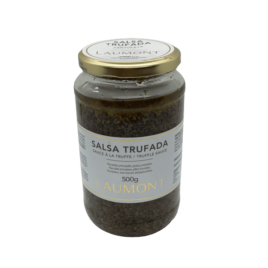Our Products
Showing 73–84 of 94 results
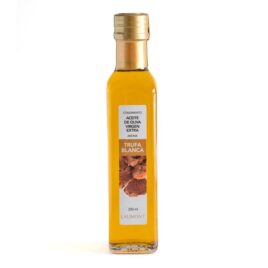
White truffle oil
Applications
Truffle everything: Bread and pizza doughs, Parmentier, sweet potato purees, potatoes, or pumpkin cream. Also, mix it with minced meat to make fillings. And for truffled desserts like ganache or white chocolate. And as far as your imagination takes you.Product Details
Ingredients- Extra Virgin Olive Oil 99,8%
- White truffle aroma 0,2%
- 250ml bottles
- 12 units per carton
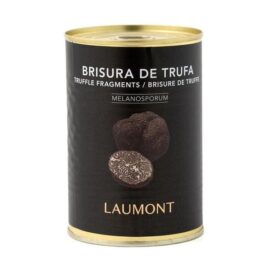
Winter truffle – fragments
Applications
Truffle everything: Bread and pizza doughs, parmentier, sweet potato purees, potatoes or pumpkin cream. Also mix it with minced meat to make fillings. And for truffled desserts like ganache or white chocolate. And as far as your imagination takes you.Product Details
Ingredients 98% wild tuber melanosporum, 1% tuber melanosporum juice and 1% salt. Shelf life and storage Once opened, keep refrigerated and consume within 5 days. Unopened, 36 months. Package- Box (200g x 6u) - 1,2kg.
- Can 200g.
- Box (100g x 6u) - 600g.
- Can 100g.
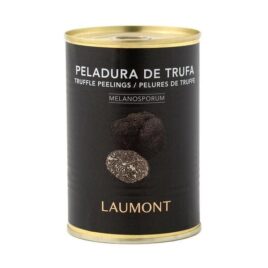
Winter truffle peeling
Applications
It is surprising to see how truffle peeling is an all-rounder for many dishes. Peel off the skin of the turkey or other poultry and place the truffle peels underneath, before baking. It gives a lot of umami. It also works with stews and sauces, they are very tasty. In addition, it can be mixed with cream cheese, risottos, polenta, even for turkey stuffing. In short, adding the truffle slices is to add depth and complexity to the dishes. And it ends up enchanting even the person who tries it for the first time. Even chefs!Product Details
Ingredients
Tuber melanosporum, tuber melanosporum juice and salt.Shelf life and storage
Once opened, keep refrigerated for 5 days. Long duration. 36 months.Package
- Box (200g x 6u) - 1,2kg.
- Can 200g.
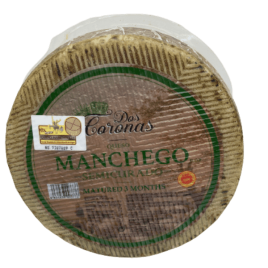
Manchego Cheese PDO
Description
Manchego is produced from sheep’s milk and comes from the La Mancha region, which is also the home of Don Quixote. It is made from pasteurised sheep's milk and is one of the most popular cheeses Spain.
There are three main varieties – semi-cured, cured and Viejo(aged)
Semi Cured, aged for 3 months and has a buttery texture and milk fruity flavour. Perfect to use in sauces, for cheese boards and croquettes. Comes in rounds between 3-3.5kg.
Cured, is aged for 6 months has a crumbly texture and rounded flavour. This cheese can be used for cheese boards, pintxos or shaved and grated as a replacement for the popular pecorino or parmigiano. Wheels come between 2.6 to 3kg.
Viejo is aged for 9 months, it is firm, more intense and crumbly in texture with a lingering palet. Fantastic combination with quince paste in desserts and also with pintxos de Jamon or other fine-cured meats. Wheels come between 2.8-3.2kg.
Pairing
Great accompanied by a dry or semi-dry fruity white wine or a smooth red wine.
Sensorial
Firm and compact cheese with small eyes. Slightly yellow colour and slightly acidic lactic aroma. Taste slightly acidic and medium to strong according to if semi matured or matured.
Download the info sheet
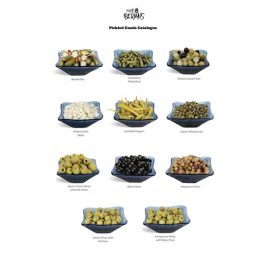
Spanish Pickles
Our products:
- Banderillas
- Cornichons (Pepinillos)
- Pickled Cocktail Mix
- Pickled Garlic (Ajos)
- Guindilla Peppers
- Capers (Alcaparras)
- Queen Green Olives (pitted & whole)
- Black Olives
- Arbequina Olives
- Green Olives with Anchovy
- Campesina Olives with Mojo Picon
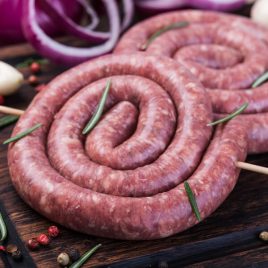
Catalan Pork Sausage
Butifarra is a product of Catalan origin, it is a pork sausauge that is seasoned with spices of which there mainly two types, the fresh butifarra and the dried sausage. The Catalan butifarra’s origin begins in the 14th century and its name is derived from the Latin root of Botillo Berciano or Galician butiello.
Over time a great variety of butifarra has emerged not only from Catalonia, this delicious sausage has spread through the Balearic Islands, Aragon, Valencia and as far as the Murcia region.
Unlike other sausages it contains no fat only lean meat from the tip of the loin and sometimes other cuts of lean pork. At most, a bit of chopped bacon is added as a condiment, but it never reaches large proportions (for example, half) as in other sausages from other countries. Sometimes the minced meat can be cooked lightly in the oven or can be seasoned with, for example, chopped mushrooms before being stuffed.
The sausage mixture is kneaded manually and then stuffed into thick pork casings 32-36mm. Then, the intestine is marked at each span with thick cotton thread and separated into different sausages, uncut, rolling each one with the casing.
The sausage is served with mongetes (white beans) it is the traditional most popular way of consuming this product, typically also in a bocadillo (bread roll) with manchego cheese or grilled with mustard or aioli. But beyond these preparations, the Catalan culinary culture has always claimed the prominence of the butifarra in a diverse and abundant cookbook.
Butifarra with its delicate aniseed and peppery flavours this sausage will harmonize with fleshy, light, dry to medium red wines.
Download our info sheet
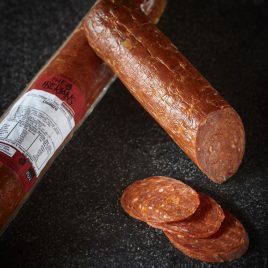
Chorizo of Pamplona
The chorizo of Pamplona (chorizo pamplonica) is the most popular and widely known of all of the pork sausages. Typically, in Pamplona and in other Navarre Pyrenees villages chorizo is stuffed into natural sausage casing 60-55mm wide and traditionally presented in the form of a horseshoe shape or in enchiladas, 10cm sections tied with natural cotton.
In southern Navarra the chorizo is smaller in diameter similar to the typical sausage, and in the central region and in the north, you will find them candle shaped which is unique to this region and called Cular (the lower part of the intestine considered a delicacy). With the fantastic climatic conditions of the north east of Navarra there are some truly delicious sausages to be had of which jaurrieta is the most prominent.
The most famous of the chorizo without a doubt is chorizo Pamplona with its specific characteristics of finely chopped pork, it is widely appreciated across Spain. The recipe is no secret – finely chop 80% of first quality pork with 20% pork fat, marinate with a dash of salt and smoked paprika add a head of chopped garlic all bought together with a little spring water. The mondongueras is left to macerate overnight and then stuffed into either artificial or natural candle shaped casings 65mm in diameter. Chorizo de Pamplona is the quintessential reflection of the Spanish nature - full bodied, spicy with delicate portions and generous flavours.
The weather of Pamplona is also another essential factor in the drying process as it takes a minimum of three months to become perfectly cured, giving the chorizo one of its most favored flavour characteristics. The chorizo is then wrapped in paper to prevent the sausage from oxidising and changing to yellowish tones, though it does not spoil its quality it will be rejected by the commercial market.
The tradition has origins from a time when people slaughtered their own meat at home and cured the sausage in their cellars. The making of this chorizo begins in winter when families traditionally slaughter the pigs and then communally make the chorizo, curing it in the cellar until the fiesta of San Fermín. Then the festival of Pamplona begins when the Chupinazo is launched (miniature rocket) and the running of the bulls commences.
In Spain this cured sausage is typically served in thin slices and has an important role in the festivals of Pamplona with the most famous “the running of the bulls”.
Download our info sheet
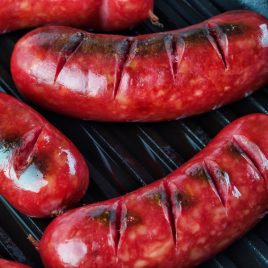
Hot / Mild Chorizo
The sausage has been around since ancient Greek and Roman times and in the 12th Century in the Romanesque Calendar of San Isidoro the month of November is called the month of the slaughter of the pigs with the pork being used for the making of chorizo and other cured and dried sausage such as the Chorizo parrillero. There are references in a famous ancient Greek comediographer, Artisphones’ literary works where the main character appeared with a pot full of sausages and with a figure of a man holding a pig for sausage making.
The chorizo acquired its characteristic red colour during the 16th Century when the paprika arrived from South America and was introduced into Spanish cuisine. In Spain, a chorizo must have garlic and paprika to be considered authentic since this is what differentiates Spanish chorizo from other sausages. It is cured outdoors or smoked, and its main base is minced pork marinated with paprika giving it its typical red colour and unmistakable full flavour.
Our chorizo is made not only from four types of pimentón with a mix of Spanish family secret herbs, it is also made from three different parts of the Linley Valley Pork – the jowl, cheek and shoulder. The pigs raised in Western Australia at Linley Valley Pork are fed on a nutritious diet of Australian grains, such as barley, wheat and lupins. This ensures a high-quality base from which The Iberians Chorizo is produced.
It has a diameter of 30-40 millimetres and string form, with a compact and firm consistency, rugged sexy appearance, smooth cut, red colour with an intense balanced aroma with a pleasant texture to the palate, and full lasting flavour, very balanced between fat and lean and includes the spicy variety.
In different regions of Spain the chorizo is cooked using a variety of methods – for instance in Galicia they serve the chorizo flamed in aguardiente (a fermented alcoholic herb liquor), in Asturias it is cooked a la sidra (with cider) or simply pan-fried in olive oil or on the BBQ.
Download our info sheet
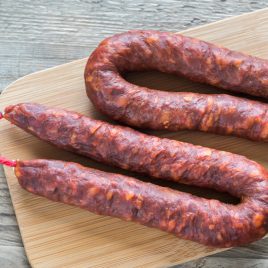
Air dried Hot / Mild Chorizo
In 15th Century Spain livestock was raised outside the cities and the animals killed in abbatoirs, the meat then sold to the butchers. But with the pigs it was different, the pig was still being raised in the villages, it was killed in the streets and the sausage was made by the family. This custom is something that still persists in some towns of Spain, el matadero (the slaughter of the pig).
It is likely that chorizo was the first cured product that due to its age and extension gained the attention of the Spanish Royal Academy of Language whom defined in the Dictionary of Authorities in 1726 as "short piece of tripe, full of meat, regularly of pork, minced and marinated, which is normally cured by smoke ". In such time the paprika was not yet common spice to the Spanish pork-butchery.
The Spanish chorizo is red due to the paprika with the ingredient arriving in Spain in the 16th Century, from the Americas. Before the paprika arrived on the Iberian Peninsula sausages were whitish or black if they were made with blood and sausage recipes can be found in ‘women’s manuals’ dating back to the 16th Century.
The chorizo picante (spicy chorizo) is made with lean and fat pork, smoked and cured, traditionally made in the winter months taking advantage of the cold and frost these conditions giving it the characteristic dark red colour and aroma. There are three types of chorizo sartar, cular and vela.
Tasting themes: sliced thin for sandwiches or tapas, fried with olive oil, cooked in stews with grains (lentils, chickpeas, white beans) plus a host of gastronomic combinations very typical of Castillian lands.
Download our info sheet

Fuet longaniza
Fuets, secallones, and somalles are dry sausages or the family of matured or "cured", typical of Catalonia, relatives of raw butifarra and sausage (fresh or dried). Its origin has to go looking for it in the Roman era, since they derive from the Lucania (from where comes the word "longaniza") that, in all likelihood, as today, was already elaborated in the Pyrenees, where the Romans (concretely of the Cerdanya) already affirmed that the best hams were made.
The Fuet de campo is a classic in the canon of the salumiere’s art. The old legend says that a light-fingered Catalan stole some regular fuet and was discovered to escape he left the sausage hidden in a patch of wild fennel. Later when he came back for it, the fuet smelled beautifully with that sweet, herby, anise aroma.
The subtle aniseed taste from the fennel is a match made in heaven that you can detect when consuming but the cured pork like all dried sausage is the true star of the show.
The traditional fuet is made from wild fennel seeds and organic Catalan vino blanco (white wine) and imparts a bolder flavour. Fennel pollen is another optional ingredient in this fuet, it has a very floral bouquet but doesn’t keep for a long time, after about six months or so, it will lose its aroma.
Most Mediterranean cultures have an anise-flavoured liqueur and this is generally added Finally, to enhance the flavour of the cured meat.
The herbs and wild fennel extend their flavours and combine perfectly with the lean pork during the curing process to produce a stunning version of this Catalan classic.
A tasting theme: tapas, charcutarie board or with a crusty baguette and for the Catalan it is an essential afternoon snack.
Download our info sheet
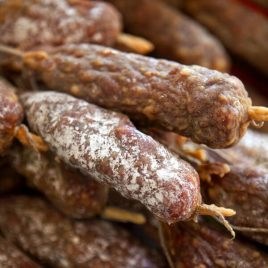
Fuet Secallona (Osona)
Fuets, secallones and somalles are from the family of matured or “cured" dry sausages, typical of Catalonia and relatives of the raw butifarra fresh or dry sausage. Lucania (where the word longaniza originates), has its roots in the Pyrenees.The origin of these sausages dates back to Roman times and is from the lucanica people (southern Italian). By all accounts the fuets, secallones and somalles were first made in the Pyrenees and due to the climatic conditions of the region they say this is where the best ‘hams’ originate.
The composition of these sausages is always pork and bacon seasoned with salt, and black pepper. The air and the microclimate of each region along with the time of maturation, do the rest. With names that sound exotic and mysterious such as Secallona, Somalla, Petador, Espetec, the truth is that they all are dried sausages that the Catalonian people refer to as fuet or longaniza. The manufacturing process is traditional, what separates them is the size. Longaniza and Secallona have a handmade quality with their appearance and fuet in contrast is shorter in size.
These different types of cured sausages are more or less regional in nature and they all follow an interesting point, in that they have an onomatopean characteristic which is the particular sound that fuet, espetec, llonganisseta, make when broken.
Within this family the secallona, somalla and petador are contemporary raw sausage products produced in two ways — long, called salsitxeta and small bite like portions cigala de gos, making them an ideal snack or finger food.
The Catalan term secallona refers to the appearance of dried fruit and this is where this pork sausage made from lean meat and pork fat stuffed into thin a natural sausage casing gets its name from. This cured dried sausage is infused with three different formats of black peppercorns powdered, cracked and whole.
A tasting theme: Secallona best sliced thick and served at room temperature and can be used in antipasto, tasting boards or in a crusty baguette drizzled with high quality Spanish olive oil.
Download our info sheet


